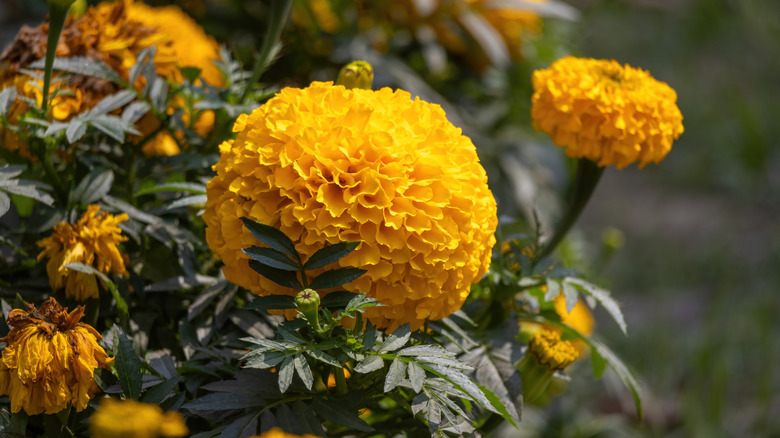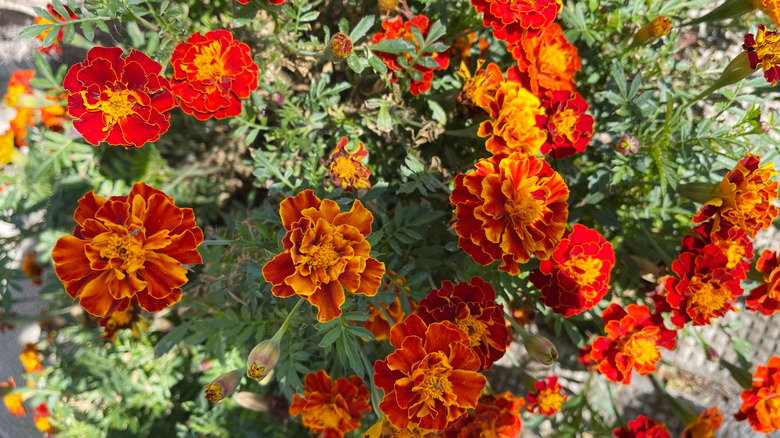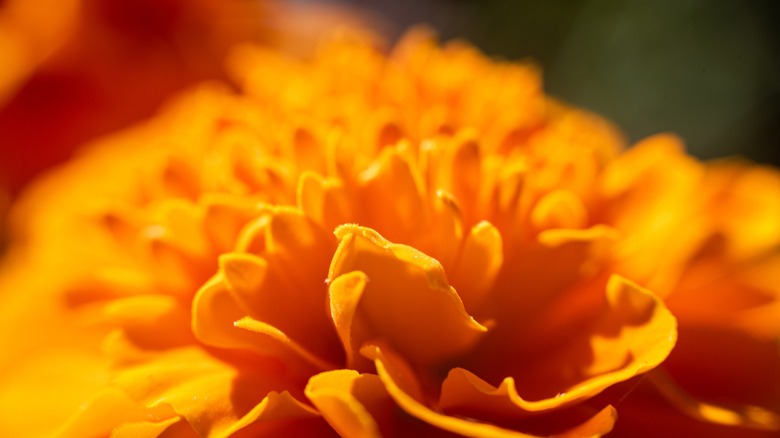Why You Should Really Consider Adding This Helpful Plant To Your Garden
Marigold flowers get a bad rap for being, well, kind of boring. And while their blooms are admittedly gorgeous, exploding in fiery reds, oranges, yellows, and a range of other hues, they're found everywhere in gardens across the globe, to the point that people often overlook them. But besides their pretty appearance, there's a good, surprisingly strategic reason gardeners so frequently plant them. These cheerful flowers are covert operatives in the fight against garden pests, a natural defense system disguised in petals that makes you wonder if plant intelligence is a real thing.
Marigolds (who belong to the genus Tagetes) have long been favored in companion planting for their pest-fighting capabilities. Their secret lies in the chemicals they release, most notably alpha-terthienyl, a compound produced by the roots of the plants that various pests like parasitic nematodes (tiny, soil-dwelling roundworms) are not big fans of. These nematodes can wreak havoc on a plant's root system, feeding off the plant while simultaneously living inside it or the ground beneath it, a fact that makes them especially difficult to get rid of. Crucially, though, when marigolds are planted next to vegetables like tomatoes, carrots, and beans, these nematodes are significantly less likely to take hold, offering your garden a natural line of protection.
The benefits extend above ground as well. Marigolds emit a distinct scent that helps repel aphids, whiteflies, and even some beetles, which might otherwise settle into a tomato plant buffet. In short, they do more than brighten your garden with splashes of color, they quietly make everything around them a little more resilient. Here's how they do it.
How marigolds protect your plants
Marigolds are botanical chemists of the best kind, and parts of the flower and what they do are pretty remarkable. The substance their roots release that helps them in their fight against nematodes, alpha-terthienyl, has the special ability to repel parasites by disrupting their biology in fatal ways, primarily by generating substances that are known to induce oxidative stress in insect cells, and particularly in nematodes' larval and juvenile forms. Essentially, once alpha-terthienyl penetrates a nematode's outer skin, it triggers a burst of reactive oxygen species, unstable molecules that damage the worm's cells by eating away at their membranes and proteins. The result? Death from oxidative stress.
But the plant has another trick up its stem: its strong scent. The potent smell that comes from the plant's flowers, especially of the French and American varieties, owes its existence to a chemical called limonene. Limonene is responsible for the sharp, fragrant smell you find in citrus peels, and it's also found in mosquito repellents. There's a good reason for that. Harmful insects, including whiteflies, which pierce a plant's surface and suck out its juices, hate limonene. In a 2019 study published in the journal PLOS One, researchers introduced whitefly populations to a group of tomato plants and then planted French marigolds nearby, leading to a significant drop in whitefly population growth.
Additional research published in Viruses has shown that, in the presence of limonene, whiteflies spend less time feeding on the plants they choose to make a meal out of. Other studies have demonstrated that dusting plants with a kaolin clay powder and combining it with limonene was enough to reduce whitefly populations on tomato crops. So, if you want your tomato plant to stay healthy, consider planting some marigolds around it.
How to use marigolds in your garden
If you've decided to add some marigolds to your garden, there are some things you need to be aware of to make sure they thrive while offering the greatest benefit to whatever other plants you're growing. The first thing you need to decide is which variety you want to plant. Not all marigolds are created equal. As we've seen, French marigolds (Tagetes patula) are the go-to option for pest control and generally prefer wet conditions. American marigolds (T. erecta) are taller and produce larger flowers, so keep that in mind if you've got limited space to work with in your yard. They're sometimes called African marigolds (despite originating in North America) and are your best option in dry conditions as they are somewhat drought-resistant.
Spacing is another key issue. When planting, think of marigolds as a defensive line and space them 18 to 20 inches apart to avoid crowding your tomatoes, beans, and carrots, which will compete with the marigolds for food and resources if they get too close. If you plant too many or place them too closely, they can easily overwhelm slower-growing plants like peppers.
Make sure to put them in well-drained soil where they'll get plenty of sun exposure throughout the day. Deadheading — the process of removing dead or wilted flowers from a plant — isn't a must for marigolds, but it will help them produce more blooms, enhancing your garden's natural pest defenses even further. Used thoughtfully, these colorful bloomers fight pests and make a great, colorful addition to any garden. And the next time you're admiring your marigold blooms, check out our breakdown of the parts of a flower to appreciate their function as well as their form.


